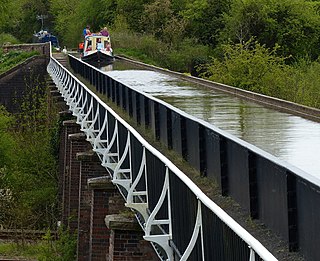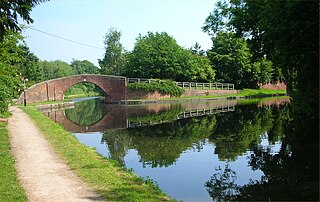Development
The first festival was held in 1950, inspired by car rallies which Tom Rolt, one of the founders of the Inland Waterways Association, had attended prior to the Second World War. It was held at Market Harborough, as the location was not restricted to narrowboats. The rally was called the Market Harborough Festival of Boats and Arts. The arts element of the festival was an addition made by Robert Aickman and was one of the elements that led to the eventual split between Rolt and Aickman. However, the festival was a success, and one of Rolt's innovations was the awarding of trophies for impressive service or performance, a practice that continued. The A. P. Herbert Trophy was awarded to the person who had traveled the furthest to get to the rally, and was won by Stan Offley, who had covered 220 miles (350 km) and had passed through 156 locks. His route from Ellesmere Port had used the Manchester Ship Canal, the Bridgewater Canal, the Leeds and Liverpool Canal, the Aire and Calder Navigation, the River Trent and the Grand Union Canal. The much shorter route using the Trent and Mersey Canal was unavailable to him, as his boat was 7.5 feet (2.3 m) wide, and the Trent and Mersey locks were only 7 feet (2.1 m) wide. [1]
Like many of the early rallies, that of 1962 was essentially a campaign to highlight the poor state of a particular waterway, in this case, the Stourbridge Canal and its connecting waterways. The decision to hold it at Stourbridge Basin was taken in late 1961, and David Hutchings, by then chairman of the rally committee, approached British Transport Waterways, the operating arm of the British Transport Commission (BTC) to ensure that the Stourbridge Branch would be dredged, to allow the boats to reach the festival site. Faced with a refusal, Hutchings hired a dragline excavator to carry out the work himself. The British Transport Commission threatened legal action against Hutchings, the Inland Waterways Association and the Staffordshire and Worcestershire Canal Society if he proceeded, but that did not stop him. His actions gained widespread media coverage, which was extremely critical of the BTC. The BTC was abolished later that year, and the rally went ahead, [2] with British Waterways staff assisting boats through the decrepit locks. Just two years later, British Waterways and the Staffordshire and Worcestershire Canal Society agreed to work on restoring the Stourbridge Canal and the Dudley Canal, and this early example of co-operation resulted in the canals and locks reopening in 1967. [3]
Marple Locks on the Peak Forest Canal was chosen as the site for the 1966 rally, again to highlight their condition. Access had to be along the Macclesfield Canal, as the locks themselves were derelict and could not be used. Cosmetic restoration began the following year, [4] and the canal was reopened in 1974. [5]
1970 was the first occasion on which the national festival was not also a campaign to save a threatened part of the waterways network. It was held at Guildford on the River Wey. Part of the reasoning for this was that the festival was proving to be very popular, and there were a limited number of places that had sufficient display space and water supply for the number of boats wanting to attend. The choice of site was not universally popular, but the rally saw the formal launching of the Waterway Recovery Group, [6] a group of volunteers who traveled the country to carry out restoration tasks on derelict waterways.
Management of the festivals is now handled by a division of Inland Waterways Enterprises Ltd called IWA Festivals. The limited company was set up in 2001 to manage the various trading activities of the Inland Waterways Association. [7] [8]
Festival of Water
In 2014 IWA launched a new event, called IWA Festival of Water. The Festival takes places usually over the August bank holiday weekend and is held at a new location each year. [9]

The River Avon in central England flows generally southwestwards and is a major left-bank and easternmost tributary of the River Severn. It is also known as the Warwickshire Avon or Shakespeare's Avon, to distinguish it from several other rivers of the same name in the United Kingdom.

The Stratford-upon-Avon Canal is a canal in the south Midlands of England. The canal, which was built between 1793 and 1816, runs for 25.5 miles (41.0 km) in total, and consists of two sections. The dividing line is at Kingswood Junction, which gives access to the Grand Union Canal. Following acquisition by a railway company in 1856, it gradually declined, the southern section being un-navigable by 1945, and the northern section little better.

The Grantham Canal ran 33 miles (53 km) from Grantham through 18 locks to West Bridgford, where it joined the River Trent. It was built primarily for the transportation of coal to Grantham. It opened in 1797 and its profitability steadily increased until 1841. It was then sold to a railway company, declined, and was finally closed in 1936. It was used as a water supply for agriculture, and so most of it remained in water after closure, although bridges were lowered. Since the 1970s, the Grantham Canal Society have been working to restore parts of it. Two stretches are now navigable to small vessels. A new route will be required where the canal joins the Trent, as road building has severed the original one.
Lionel Thomas Caswall Rolt was a prolific English writer and the biographer of major civil engineering figures, including Isambard Kingdom Brunel and Thomas Telford. He is also regarded as one of the pioneers of the leisure cruising industry on Britain's inland waterways, and was an enthusiast for vintage cars and heritage railways. He played a pioneering role in both the canal and railway preservation movements.

Robert Fordyce Aickman was an English writer and conservationist. As a conservationist, he co-founded the Inland Waterways Association, a group which has preserved from destruction and restored England's inland canal system. As a writer, he is best known for his supernatural fiction, which he described as "strange stories".

The Inland Waterways Association (IWA) is a registered charity in the United Kingdom which was formed in 1946 to campaign for the conservation, use, maintenance, restoration and sensitive development of British canals and river navigations.

The Bugsworth Basin Heritage Trust (BBHT), formerly known as the Inland Waterways Protection Society (IWPS), is a British organisation founded in 1958 to work for the restoration of the canal system. Its members carried out surveys of canals and produced reports in support of their retention when much of the canal network was under threat. Following official support for use of the canals for leisure activities in 1967, the Society have concentrated their efforts on the restoration and operation of Bugsworth Basin, located at the southern end of the Peak Forest Canal, which was one of the first canals that they surveyed in 1958.

The Stourbridge Canal is a canal in the West Midlands of England. It links the Staffordshire and Worcestershire Canal with the Dudley Canal, and hence, via the Birmingham Canal Navigations, to Birmingham and the Black Country.

The Waterway Recovery Group (WRG) is the national co-ordinating body for voluntary labour on the inland waterways of England and Wales. Founded in 1970 as an independent body, it became a division of the Inland Waterway Association in 2002.
Ellis Charles Raymond Hadfield was a canal historian and the author of many classic works on the British canal system, mostly published by the firm he co-founded, David & Charles.

Kings Norton Junction is the name of the canal junction where the Stratford-upon-Avon Canal terminates and meets the Worcester and Birmingham Canal at Kings Norton, Birmingham, England.

The Four Counties Ring is a canal ring which links the four English counties of Cheshire, Staffordshire, Shropshire and West Midlands.

The North Pennine Ring is a canal ring which crosses the Pennines between Manchester, Leeds and Castleford. It follows parts of five canals, and shares much of its route with the Outer Pennine Ring, which uses a different route for the southern crossing of the Pennines.

Marple Junction is the name of the canal junction where the Macclesfield Canal terminates and meets the Peak Forest Canal at Marple, Greater Manchester, England.

Dukinfield Junction is the name of the canal junction where the Peak Forest Canal, the Ashton Canal and the Huddersfield Narrow Canal meet near Ashton-under-Lyne, Greater Manchester, England. The area has been designated by Tameside Metropolitan Borough Council as a conservation area.

Kingswood Junction is a canal junction where the Stratford-upon-Avon Canal meets the Grand Union Canal at Kingswood, Warwickshire, England.

Delph Locks or the Delph Nine are a series of eight narrow canal locks on the Dudley No. 1 Canal in Brierley Hill, in the West Midlands, England. They were opened in 1779, and reopened in 1967 following restoration of the Dudley Canal and the Stourbridge Canal in a joint venture between the Staffordshire and Worcestershire Canal Society and the British Waterways Board.

Narrow Boat is a book about life on the English canals written by L. T. C. Rolt. Originally published in 1944 by Eyre & Spottiswoode, it has continuously been in print since.

Sonia Rolt OBE was a campaigner for the Inland Waterways Association (IWA) of Great Britain and was made an Officer of the Order of the British Empire in 2010 for her services to industrial archaeology and heritage.
The Seven Wonders of the Waterways is a list of landmarks on the navigable waterways of the United Kingdom. The list was originally compiled in 1946 by Robert Aickman, co-founder of the Inland Waterways Association (IWA), at a time when the waterways network was largely derelict. Today, the Canal & River Trust—formerly British Waterways—has jurisdiction over all of the sites except for the Barton Swing Aqueduct, which is owned and operated by the Bridgewater Canal Company.
















